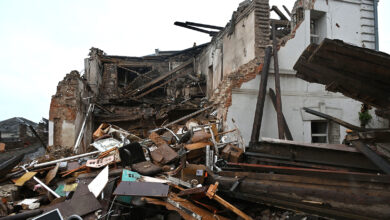The Museum of Islamic Art in downtown Cairo, closed for renovations since 2003, was reopened yesterday by President Hosni Mubarak. It is thought to be among the most important museums of Islamic art in the world.
The president was accompanied at the ceremony by Prime Minister Ahmed Nazif, Minister of Culture Farouk Hosni, and the Secretary General of the Supreme Council of Antiquities Zahi Hawwas.
Hawwas and Hosni presented President Mubarak with the museum’s platinum shield, a replica of the museum's facade, one of Cairo’s most outstanding landmarks of Islamic architecture.
The museum was established in 1903 during the reign of Abbas Helmi II, then the Khedive of Egypt.
103,000 pieces were renovated over an eight-year period, with the total cost reaching LE58 million (US$10.180 million). The museum’s management exhibited close to 2,000 artifacts inside closets and against walls next to the building’s front area.
The museum's department at the Council of Antiquities worked on installing an addition to the museum in a style which copies that of the administrative offices, the conference hall, the library, shops, and the guest hall. The addition houses 25 exhibition rooms outfitted with alarm systems, fire alarms, and monitoring cameras.
Artifacts are organized according to historical era and artistic genre. Among the pieces exhibited was a pitcher belonging to Marawan ibn Mohamed, the last ruler of the Umayyad caliphate. The bronze pitcher, which dates back to year 132 of the Islamic calendar, is 41 cm tall and 28 cm wide.
The culture minister explained in an earlier visit that the piece is one of the museum’s most precious items, noting that it was discovered near the caliph’s tomb at Beni Suef. No evidence has yet been provided to establish the piece as one of Marwan’s possessions.
Another important piece on display was an icon displaying a picture of Jesus, discovered at the historical city Futstat, Cairo.
Located in downtown Cairo, the museum contains a diverse collection representing Islamic art from China, India, Iran, the Arab Peninsula, the Levant region, Egypt, North Africa, Andalusia, and other parts of the Islamic world.
The museum has the world's largest collection of Islamic art. It first opened on 28 December, 1903, at Bab el-Khalq square, one of Cairo’s most famous historic areas. It neighbors some prominent examples of Islamic architecture such as the Ibn Tolon Mosque, the Shrine of Sayyida Zeinab, the Sultan Hassan Mosque, Mohamed Ali’s Mosque, Saladin Citadel, and al-Refae Mosque.
Because of its diversity of antiquities, either in terms of material (wood, metal, textile, stone) or source, the museum also serves as the world's best educational institution for Islamic Art.
Among the exhibited work is a rare collection of textiles, seals, Iranian and Turkish carpets, and Ottoman glass and pottery. Additionally, the museum holds rare tools used in a number of fields such as astronomy, geometry, chemistry, and medicine; equipment used in cupping–a therapy adopted during the prosperous phases of Islamic civilization–are also on display.
There are also tools for measuring distance, hourglasses, lanterns made of enamel-plated glass, Egyptian pottery from the Fustat excavations, and Fatimid pottery, which is distinctive for its metallic sheen.
The museum also hosts excellent collections of wooden objects from the Umayyad era, such as corbels from the Amr Ibn al-Aas Mosque, which go back to the early eighth century. There are also wooden objects from the Abbasid era, unique for their “Samarra style” ornaments, which originated in Iraq.
Among the exhibits, there is a headstone dating back to 650 A.C. (year 31 of the Islamic calendar).
A rare manuscript by ِAbu Gaafar al-Ghafiki, an Islamic medieval scientist in the field of herbal medicine, called Fawaeyd el-Aashab (The Benefits of Herbs) is displayed beside two exceptional copies of the Holy Quran from the Mamluk and Umayyad eras, written on gazelle parchments. Other copies of the Quran are decorated with gold ink.
The museum also hosts the key of the holy Kaaba. Made of copper and coated in gold and silver, it carries the name of Sultan al-Ashraf Shaaban. Additionally, the museum holds a golden dinar dating back to the year 697 A.C (year 77 on the Islamic calendar), making it the oldest Islamic coin yet discovered.
There is also a collection of kohl sticks and scales from the start of the Umayyad and Abbasid eras, as well as medals and badges belonging to the Ottoman era and the rule of Mohamed Ali.
Visitors can also view a valuable collection of wool and silk carpets that date back to the medieval Seljuq, Safavid, and Mongol eras.
Translated from the Arabic Edition.




